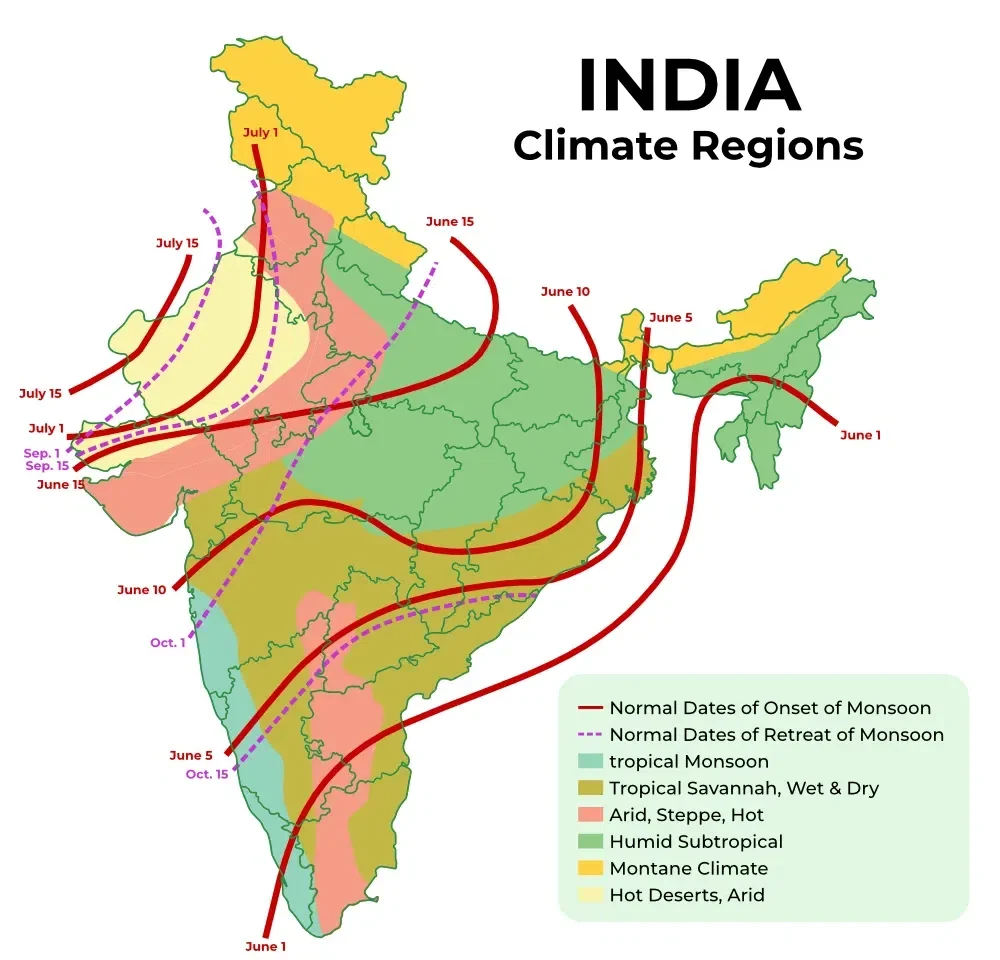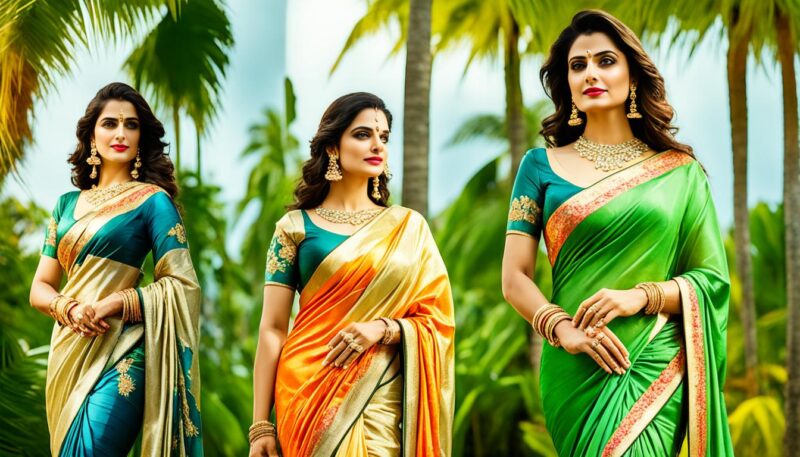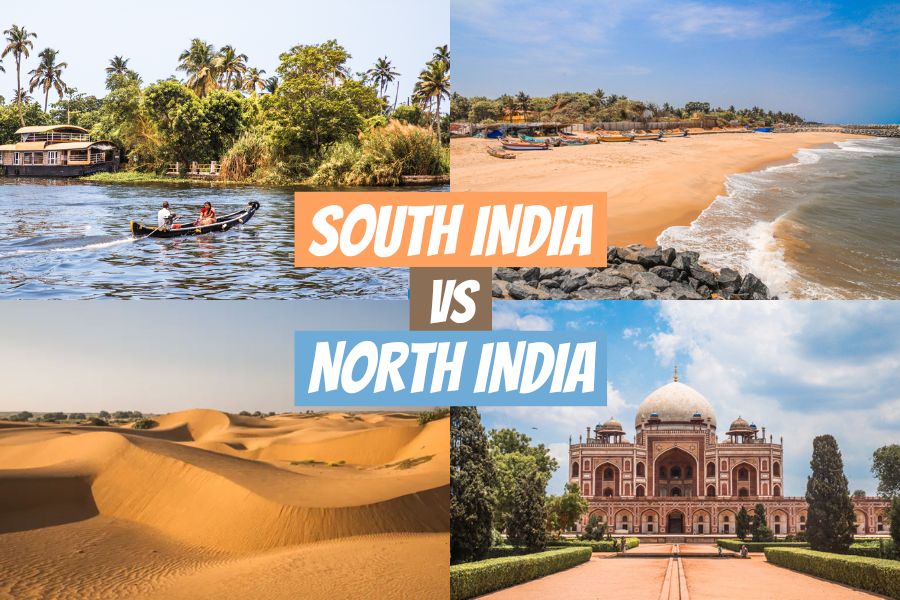India is home to over 1.3 billion people, ranking it as the world’s second-most populous nation. It’s a vast and diverse country with major regional differences. These differences greatly influence the culture across the land. North India and South India stand out for their unique traditions, languages, and food. They also differ in their architectural designs.
Key Takeaways:
- India has distinct regions, with North India and South India showing noticeable differences.
- The two areas differ in climate, food, temple design, what people wear, and their musical and dance styles.
- Learning about these variations helps us better understand India’s cultural richness.
- Exploring both North and South India reveals beautiful traditions, diverse languages, food variety, and architecture.
- The differences highlight India’s incredibly rich cultural heritage.
Weather and Climate

North India and South India stand out with their unique weather and climate. The Himalayas heavily influence North India’s climate. This leads to different weather throughout the year.
North India Climate and Weather Patterns
Winter here is cool and dry, ranging from 10°C to 15°C (50°F to 59°F). Meanwhile, summer brings high temperatures, from 32°C to 45°C (90°F to 113°F). This hot, dry season is great for tourists visiting cities rich in history like Delhi, Jaipur, and Agra.
The monsoon season from June to September offers a break from the heat. It brings heavy rain, which helps crops grow and paints the landscape green. Hill stations like Shimla in Himachal Pradesh become especially beautiful during this time.
South India Tropical Climate and Monsoon Season
South India enjoys a warm, tropical climate. Temperatures range from 25°C to 35°C (77°F to 95°F) all year round. This area sees less temperature change compared to North India.
Winters here are drier, with less rainfall between November and April. Kerala, the “land of backwaters,” experiences a unique secondary monsoon from mid-October to mid-November. This brings beauty and greenery to the state.
With its tropical climate, South India is a great place to visit year-round. It offers beautiful beaches, dense forests, and stunning views everywhere. Destinations like Chennai, Bangalore, and Kochi blend history, modernization, and coastal beauty.
Both North and South India have their special weather features and attractions. Whether you like the seasons of the North or the steady tropical warmth of the South, there is much to enjoy in both regions.
| North India | South India |
|---|---|
| Distinct seasons: cool and dry winter, hot summer | Consistent tropical climate throughout the year |
| Monsoon season from June to mid-September | Drier winters with less rainfall |
| Weather influenced by the Himalayas | Humidity and warmth |
| Prefect time to visit historical and cultural sites | Picturesque beaches and lush landscapes |
Language
India’s languages are a key part of its rich culture. North and South India show this well. Their language families reflect unique histories and places.
In the North, Indo-Aryan languages are common. Hindi, the top language of India, comes from here. You also hear Urdu, Punjabi, Bengali, and Gujarati. These use extra parts in their words to show grammar.
In South India, Dravidian languages are key. Here, languages like Telugu, Tamil, Malayalam, and Kannada are spoken. Dravidian languages use extra parts in words, too. This is for showing grammar. For instance, in Tamil, the word “kudiyiruppu” shows someone “is in the house.”
The many languages of North and South India show the country’s deep culture. They are not just for talking. They also keep old stories and traditions alive.
You can also read: Exploring the Richness of Nepal Culture & Traditions
Food
Indian food is a big part of the culture and it’s both diverse and tasty. Northern and southern areas of India have very different food styles.
In North India, you’ll find a lot of food made with wheat. This includes foods like roti, naan, and paratha. Your meal might be served with rich gravies such as butter chicken.
They also have spicy kebabs and a variety of deep-fried snacks, perfect for eating on the go.
On the other side, South Indian foods mostly focus on rice and lentils. Breakfast items like idli, dosa, and vada are popular. They come with chutneys and sambar for dipping.
Coconut is a big part of their diet, especially in coastal areas. You’ll find a lot of dishes with coconut, along with fresh seafood.
Spices make a big difference in the foods from these two areas. North Indian food usually has heavier flavors. They use spices like cumin and garam masala. South Indian cuisine prefers curry leaves and coconut, offering a more subtle taste.
Both parts of India offer amazing food experiences. They show the great culinary tradition and the country’s many cultures.

Image: North Indian thali and South Indian thali showcasing the diversity of cuisine in both regions.
Temple Architecture
Hindu temple styles vary significantly between North and South India. They’re known for distinct designs and practices. The differences make for a rich variety of temple types.
North India Temple Architecture: Nagara Style
In North India, temples are built in the Nagara style. These structures have detailed carvings, tall spires, and amazing sculptures. They are often found in beautiful natural spots. Such locations enhance the spiritual experience for visitors.
“The Nagara style of temple architecture in North India is a testament to the rich cultural heritage of the region.”
South India Temple Architecture: Dravida Style
South India’s temples follow the Dravida style. They are famous for their large entrance towers, called gopurams. These gopurams are filled with sculptures of gods and heroes. The beauty of these sites leaves people in awe.
“The Dravida style of temple architecture in South India stands tall and majestic, captivating devotees and tourists alike.”
Temples play a vital role in the lives of people in both regions. They are hubs for religious activities and cultural events. People visit these temples to get closer to their faith, find peace, and connect with the spiritual world.
| North India Temple Architecture | South India Temple Architecture |
|---|---|
| Follows the Nagara or Indo-Aryan style | Characterized by the Dravida style |
| Smaller temples situated in scenic natural locations | Features towering gopurams (gateways) |
| Intricate carvings, spires, and sculptures | Elaborate sculptures of Hindu deities and mythological figures |
| Serene ambiance amidst nature | Majestic and grand architectural presence |
Clothing
In North and South India, traditional clothes highlight cultural differences. Women in North India wear salwar kameez or churidar suits, which are pretty and classy. Men there dress in pants, shirts, and kurtas.
On the other hand, South Indian women prefer to shine in saris and half saris. These outfits are famous for their vivid colors and detailed designs, showing the area’s rich culture and art. Men’s wear in South India is comfortable, with many choosing white dhotis. They also like to lounge in colorful lungis.

All across India, saris symbolize elegance for women. However, there are North and South Indian styles of saris. In the north, saris are draped differently and styled uniquely. These differences demonstrate the country’s diverse and unique cultural richness.
Comparison of Traditional Attire in North India and South India
| Region | Women | Men |
|---|---|---|
| North India | Salwar Kameez or Churidar | Pants, Shirts, and Kurtas |
| South India | Bright-Colored Saris and Half Saris | White Dhotis or Colorful Lungis |
Music and Dance
Classical Music
North India and South India each have unique classical music styles. In North India, they play Hindustani classical music. This music has been influenced by foreign cultures and uses instruments like the sitar and tabla.
South India has Carnatic music. It is very spiritual and has a long history. The mridangam and veena are some of the instruments used, creating a beautiful sound. This music is known for its detailed compositions and rhythms.
Dance Forms
North India and South India have beautiful dance forms that tell stories. Each style has its own unique look and theme.
- Bharatanatyam is from South India. It started in Tamil Nadu’s temples. It uses graceful moves to tell Hindu myths. Other dances in the south are Kuchipudi, Kathakali, and Mohiniyattam, each with its own special features.
- Kathak is prominent in North India. It focuses on footwork and rhythm. It tells stories through dance, captivating the audience. Bhangra, Rasleela, Nati, and Dumhal are dances from the north that show its cultural richness.
Dance in North and South India shows the country’s diverse culture and art.
Comparison of North Indian and South Indian Music and Dance Forms
| Aspect | North Indian Classical Music | South Indian Classical Music | North Indian Dance Forms | South Indian Dance Forms |
|---|---|---|---|---|
| Main Music Genre | Hindustani Classical Music | Carnatic Music | Kathak | Bharatanatyam |
| Instruments | Sitar, Tabla, Sarod | Mridangam, Veena, Violin | Tabla, Sitar, Sarod | Mridangam, Veena, Violin |
| Main Characteristics | Influenced by Persian and Arabic music | Deeply rooted in spirituality | Intricate footwork, rhythmic patterns | Graceful movements, expressive storytelling |
| Popular Dance Forms | Kathak, Bhangra, Rasleela, Nati, Dumhal | Bharatanatyam, Kuchipudi, Kathakali, Mohiniyattam | Kathak, Bhangra, Rasleela, Nati, Dumhal | Bharatanatyam, Kuchipudi, Kathakali, Mohiniyattam |
Conclusion
North and South India differ a lot in things like weather, language, food, and clothes. They also vary in temple design, music, and dance. This diversity is what makes India’s culture so rich and colorful.
Diving into each region’s unique traits is both exciting and educational. You can experience North India’s cold winters, hot summers, or South India’s delicious rice dishes. Discovering these differences is truly captivating.
The temples in both regions are distinct, showcasing unique architectural styles. These styles highlight different worship practices and cultural norms. likewise, What people wear, the music, dances, and languages show the wide array of cultural experiences in India.
FAQ
What are the key differences between North India and South India?
In India, the weather, language, food, and much more change as you go from the North to the South. You’ll find different types of temple architecture, clothing, and various music and dances.
How does the weather differ between North India and South India?
Northern India has a cool, dry winter and a hot summer. It’s also home to a monsoon season from June to September. In contrast, South India has warmer, tropical weather with higher humidity all year round.
What languages are spoken in North India and South India?
North India mainly speaks Hindi, Urdu, and Punjabi. These languages are part of the Indo-Aryan family. South India uses Telugu, Tamil, Malayalam, and Kannada, which are from the Dravidian family.
How does the cuisine differ between North India and South India?
The food in North India focuses on wheat-based dishes and rich gravies and includes spicy kebabs and samosas. South India prefers rice and lentils, offering dosas, idlis, vadas, and uttapams. Along the coasts, coconut and seafood are common.
What are the architectural differences between North Indian and South Indian temples?
The temples of North India follow the Indo-Aryan style and are often found in natural settings. South Indian temples, however, have towering gopurams and unique towers inside. The two regions boast different temple styles, tower shapes, and worship practices.
How does traditional attire differ between North India and South India?
In North India, you’ll see women in the salwar kameez and men in kurtas, while South Indian women wear vibrant saris. Men in the South often choose white dhotis or colorful lungis. Sari wearing is widespread, but styles differ across India.
What are the differences in music and dance between North India and South India?
North India celebrates Hindustani classical music and dances like Kathak. South India has its own Carnatic classical music and dance forms such as Bharatanatyam, Kuchipudi, and others. Each area has its unique musical and dance traditions.
What are the cultural differences between North India and South India?
The two regions of India have their own languages, food, temples, and clothing. Both North and South India are rich in distinct music and dance. This variety creates the colorful cultural tapestry of India.
Why should one explore both North India and South India?
Visiting both parts of India is a fantastic way to enjoy the country’s varied cultures. It shows you the unique climate, food, languages, and more, making India a rich and diverse place to explore.
